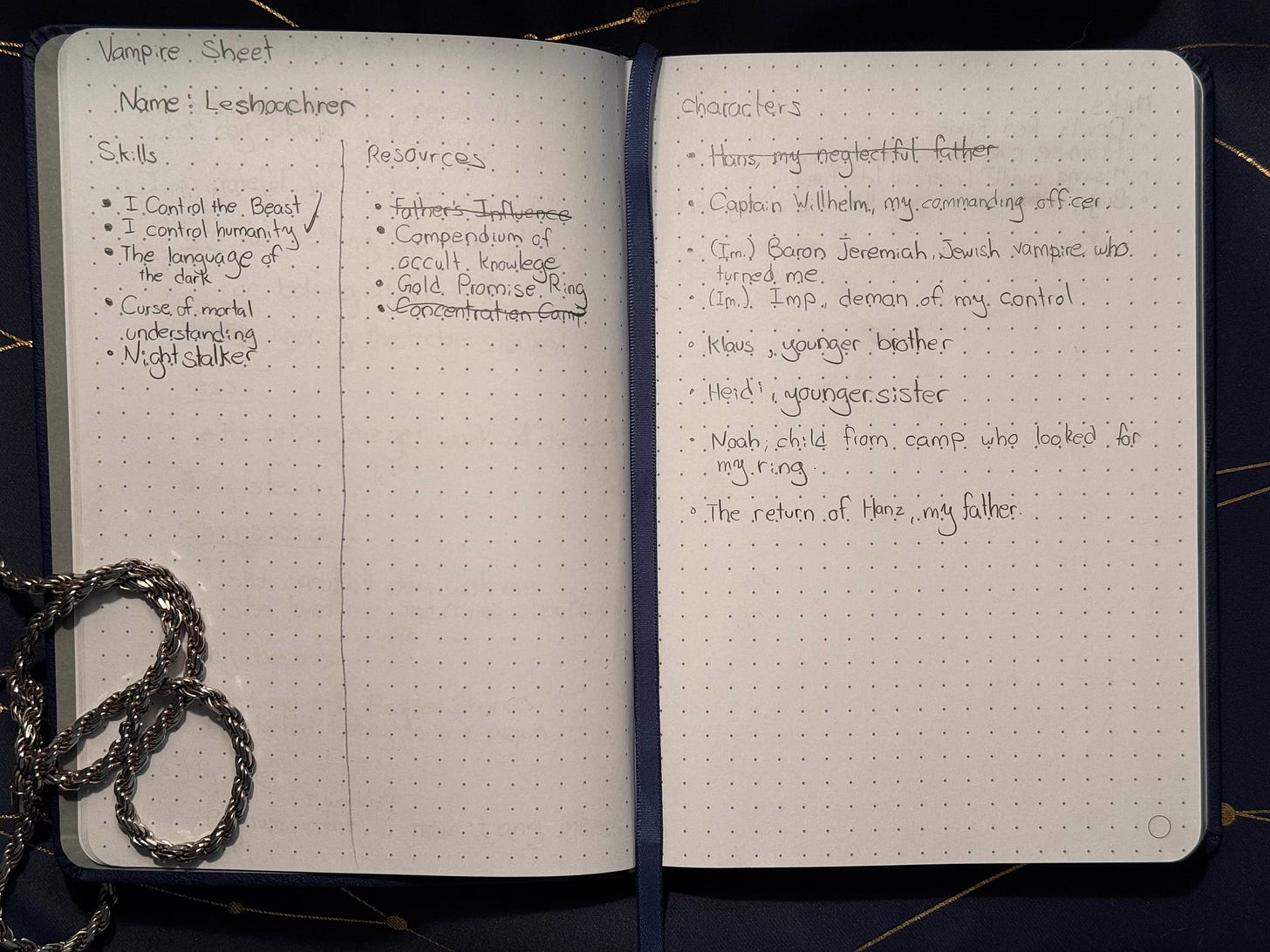Are you someone who always wanted to take a stab at creative writing? Are you someone who loves Tabletop Role Playing Games (TTRPG’s) but find the live action role playing difficult?
If you identify with some of those, all of those, or none of those, I have a proposition for you. What if you could create the story of a vampire who’s life spans decades. What if a book held your hand along the way to give you interesting ideas. What if you could play this game with other people, but without real-time social interaction.
I present to you: Thousand Year Old Vampire a journaling game by Tim Hutchings.
I cannot describe to you how much I love this game, and I hope by the end of this article you’ll be foaming at the mouth to give it a shot yourself.
What is Thousand Year Old Vampire?
Thousand Year Old Vampire was put on my radar by Quinns, the legendary board game reviewer for Shut Up & Sit Down, a journalist for People Make Games, and the showrunner for Quinns Quest a show about TTRPG’s. Quinns is responsible for much of my paycheck transforming into cardboard and wood trinkets.
Thousand Year Old Vampire (TYOV) is a journaling game where you chronicle the centuries long life of a vampire you create.
Thousand Year Old Vampire starts, like all other great TTPRG’s, with a book, a character sheet and some dice. That’s where the similarities end however. Firstly, TYOV can be played solitary.
As someone who used to sit in his room pretending to play board games with other people, it’s nice to get to play it for real.
In TYOV you get to create a person who, through good luck or bad, gets turned into a vampire. A medieval knight, the pope, a corrupt cop, the options are only limited by your imagination.
Your instructions are simple.
Create a person in a time period
Who do they know?
What do they have?
What can they do?
Then it gets more interesting.
Who turned them?
How did that irreparably scar them?
Now your game starts. I love that the game starts you at the good part. I wouldn’t want to role play the person before they become a vampire waiting for the game to get interesting. The setup time takes about an hour your first time, then about a half an hour after that.
Its extremely refreshing when compared to something like DnD which takes an entire session just to build a character.
After that the game throws you right into the action.
Game Systems
Like the rest of the game what I really like about TYOV is how simple and elegant the game systems are.
The story of your vampire starts with the simple roll of two dice. The majority of the content of the beautifully designed book are prompts that you, as the player, must answer.
“You killed someone close to you. Why? Lose a character.”
Often times that is as much detail as you get, but the game also encourages you to be brief. It doesn’t want you spending too much time worrying about the specifics. You’ll have more fun playing quick and imaginatively.
What’s even more interesting is that it’s possible to roll backwards through the prompts as well. If you land on a prompt multiple times you get asked a follow up question which continues the thread of action and consequence.
A character you’ve victimized comes to you in a dream. Do they curse or forgive you?
Additionally the game encourages you to play non-chronologically. I’ve still yet to fully take advantage of this system, but it does provide help in the storytelling.
Your character has access to five memories total each of which is made up of three events. When you draw a new prompt it can either append it to the details of an existing event. Make it the next event in a memory with an open event slot, forcing you to continue the story of that memory rather than just creating a new plotline.
When you have filled up all your Memories with three events, or you draw a prompt that doesn’t fit into any memories you can create a new memory at the cost of forgetting an old memory.
Your character lives a long time. It’s impossible for someone immortal to remember all the details of their lives, and this system creates more interesting interactions where memories dear to them can be held on to at the cost of hold more of your recent experiences.
The way this is implemented is ultimately up to the player —you’re the one telling the story. Having a character who’s forgotten something adds additional detail to an event that might otherwise be mundane.
The game ends when you face an encounter that you can’t overcome using your skills, characters, or resources, and you are ultimately defeated.
Final Thoughts
It goes without saying that I love Thousand Year Old Vampire. I have to pull myself away from the book because my mind is racing with the possibilities of what secrets just one more prompt might hold in the slowly unraveling tapestry that is my vampire.
How can you play?
Here: Thousand Year Old Vampire
There is a download online for the PDF which you can buy for $20. That’s frankly a steal for such an amazing journaling game. Alternatively you can get the lusciously designed physical copy of the game. The physical print is Lovecraftian eye-candy and I would pay the price just have it on my coffee table —if I had one.









